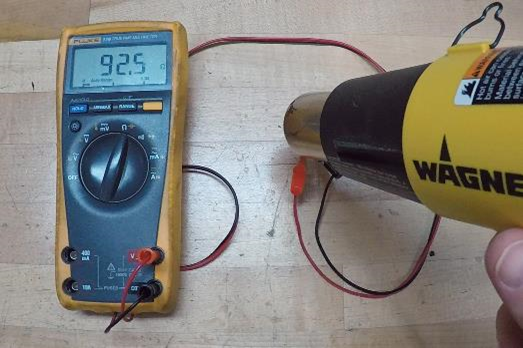When you specify a resistor for your project, you expect it to maintain its value over a reasonable temperature range. Manufacturers design their resistors to display their value, even though some variation occurs depending on the component’s temperature. This temperature fluctuation may result from restive heating, via outside temperature variations, or when the component accepts a current.
What Does a Thermistor Do?
Thermistors, or “thermally sensitive resistors,” take advantage of this normally undesirable property. They measure ambient temperature or control current directly based on the component’s resistance. They’re designed not to minimize temperature-based resistance variation, but to exhibit a wide range of values instead.
Typically, thermistors are made from ceramic or polymer, and they come shaped into beads, rods, and disks. They can be extremely small, ranging from a restive sensing element just over a millimeter in diameter, up to much larger sizes that can handle a significant amount of current.
Types of Thermistors: PTC & NTC
- NTC Thermistors: Negative temperature coefficient devices – where resistance decreases as temperature rises.
- PTC Thermistors: Positive temperature coefficient devices – where resistance rises with increasing temperatures.
Electronics pioneer Michael Faraday first discovered this effect in 1833, noting that silver sulfide changed its resistance with changes in temperature. Incidentally, this discovery also marked the first recorded observation of a material exhibiting semiconducting properties. Thermistor-based devices, however, didn’t reach widespread production until nearly a century later when Samuel Ruben, the founder of Duracell, invented the first commercially viable thermistor in 1930.
Modeling Thermistor Resistance
We can model a thermistor’s expected resistance based on temperature in at least three ways.
- A First-Order Approximation. While this solution is both simple and mathematically expedient, the equation we use to obtain resistance is only viable over a limited temperature range:
ΔR = kΔT
Per this model, the change in resistance in a thermistor equals the temperature coefficient (k) multiplied by the change in temperature. Note that k can be positive or negative, dictating whether the resistance goes up or down (PTC or NTC) with temperature as noted previously.
- The Steinhart-Hart Equation. This equation allows for a better approximation over a larger range of temperatures by using three parameters: a, b, and c. These parameters help account for a thermistor’s non-linearity:
1/T = a + b ln(R) + c(ln(R))3
- B Parameter Equation. We can also abbreviate the Steinhart-Hart method into the B (or β, beta) parameter equation, using values or the thermistor’s resistance at 25°C as R0 and a B parameter specified for an individual thermistor. We write this equation as:
R = r∞eB/T
where r∞ = R0e-B/T0
We calculate B experimentally based on the measured resistance at two temperatures, where R1 is the resistance at temperature 1 (T1), and R2 is the resistance at temperature 2 (T2). Note that we are stating temperature here in degrees Kelvin, and the results are a dimensionless value. For example, the thermistor in this article’s first image has a specified B value of 3950:
B = ln(R1/R2) / (1/T1 - 1/T2)
Thermistor Sensors and Direct Control

Resistance of this tiny thermistor quickly varies from close to 100 kohm to less than 100 ohms when heated. Image by Jeremy S Cook.
Aside from PTC and NTC, we may also broadly classify thermistors as sensing and direct control components.
- Sensing thermistors tend to be very small NTC devices, but you can also purchase somewhat larger units for certain applications. External equipment reads the resistance, passing very little current through the thermistor so as not to affect temperature readings. You can find these devices acting as sensors in automotive applications, appliances, and even 3D printers, where they regulate the temperatures needed for proper extrusion. In all these applications, resistance – and thus temperature – passes to an external device for control.
- Direct control thermistors tend to be larger and may be either PTC or NTC. You can use PTC thermistors as a replacement for fuses; when a large enough current passes through the component, it generates heat, increasing resistance and restricting current flow. You may see this type of thermistor used as a timer; the thermistor heats up sufficiently to “clamp down” on current flow after a set amount of time.
For their part, we can use NTC thermistors as inrush current limiting devices, where a small amount of current initially flows through the device. As the device heats up, it allows more current to flow with decreasing resistance.
Thermistors vs Thermocouples, Resistance Thermometers, and Varistors
Thermistors aren’t the only devices that measure temperature. You can also use:
- Thermocouples consider the electrical effects of two different conductors connected together.
- Resistance thermometers, which use metal instead of a thermistor’s ceramic or polymer.
- Varistors, which resemble thermistors in some ways. These devices perform a similar function to thermistors but vary resistance based on voltage instead of temperature.
Overall, thermistors represent a clever but simple concept: using a normally undesirable resistor property for direct control and information gathering. Whatever your sensing needs may be, you can find a wide variety of thermistors available to suit your application – or to replace one that has failed.


